1995 CADILLAC SEVILLE traction control
[x] Cancel search: traction controlPage 208 of 410
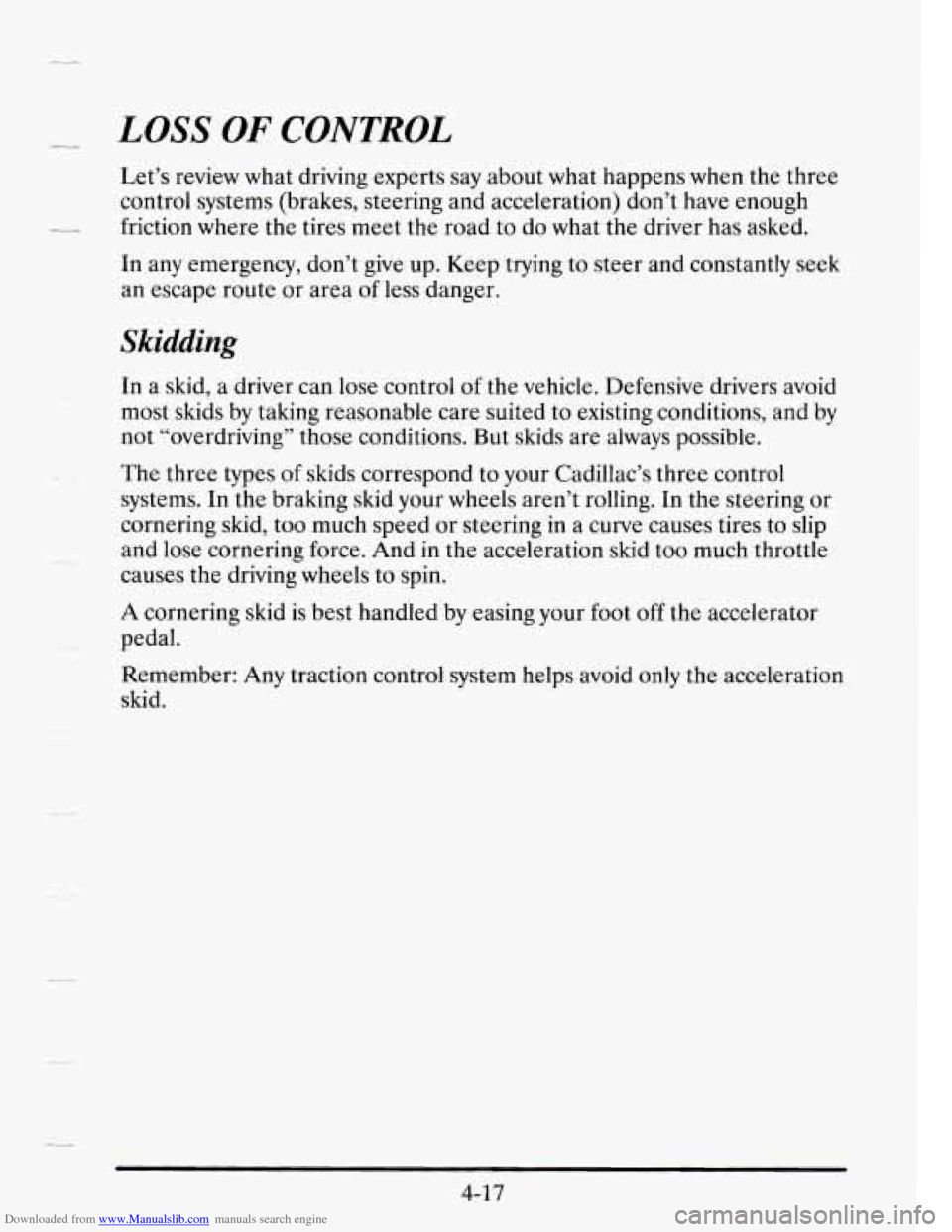
Downloaded from www.Manualslib.com manuals search engine LOSS OF CONTROL
Let’s review what driving experts say about what happens when the three
control systems (brakes, steering and acceleration) don’t have enough
friction where the tires meet the road to do what the driver has asked.
In any emergency, don’t give up. Keep trying to steer and constantly seek
an escape route or area of less danger.
Skidding
In a skid, a driver can lose control of the vehicle. Defensive drivers avoid
most skids by taking reasonable care suited to existing conditions, and by
not “overdriving” those conditions. But skids are always possible.
The three types
of skids correspond to your Cadillac’s three control
systems.
In the braking skid your wheels aren’t rolling. In the steering or
cornering skid, too much speed or steering in a curve causes tires to slip
and lose cornering force. And in the acceleration skid too much throttle
causes the driving wheels to spin.
A cornering skid is best handled by easing your foot off the accelerator
pedal.
Remember:
Any traction control system helps avoid only the acceleration
skid.
Page 209 of 410
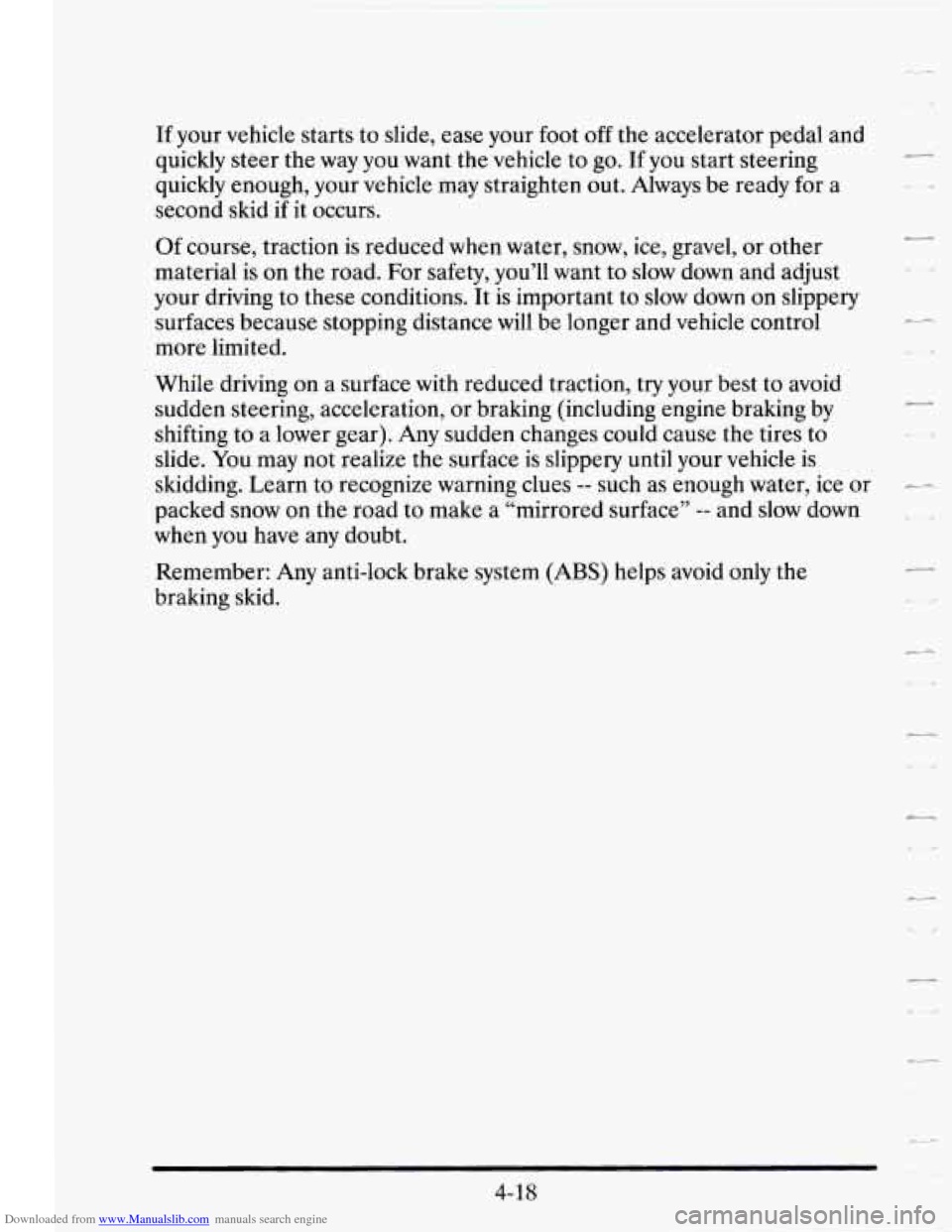
Downloaded from www.Manualslib.com manuals search engine If your vehicle starts to slide, ease your foot off the accelerator pedal and
quickly steer the way you want the vehicle
to go. If you start steering
quickly enough, your vehicle may straighten out. Always be ready for a
second skid
if it occurs.
Of course, traction is reduced when water, snow, ice, gravel, or other
material is on the road. For safety, you’ll want to
slow down and adjust
your driving to these conditions. It is important to slow down on slippery
surfaces because stopping distance will be longer and vehicle control
-
more limited.
r
While driving on a surface with reduced traction, try your best to avoid
sudden steering, acceleration, or braking (including engine braking by
shifting to a lower gear). Any sudden changes could cause the tires to
slide. You may not realize the surface is slippery until your vehicle is
skidding. Learn to recognize warning clues
-- such as enough water, ice or --
packed snow on the road to make a “mirrored surface” -- and slow down .
when you have any doubt.
Remember: Any anti-lock brake system
(ABS) helps avoid only the
braking skid.
4-18
c
Page 225 of 410
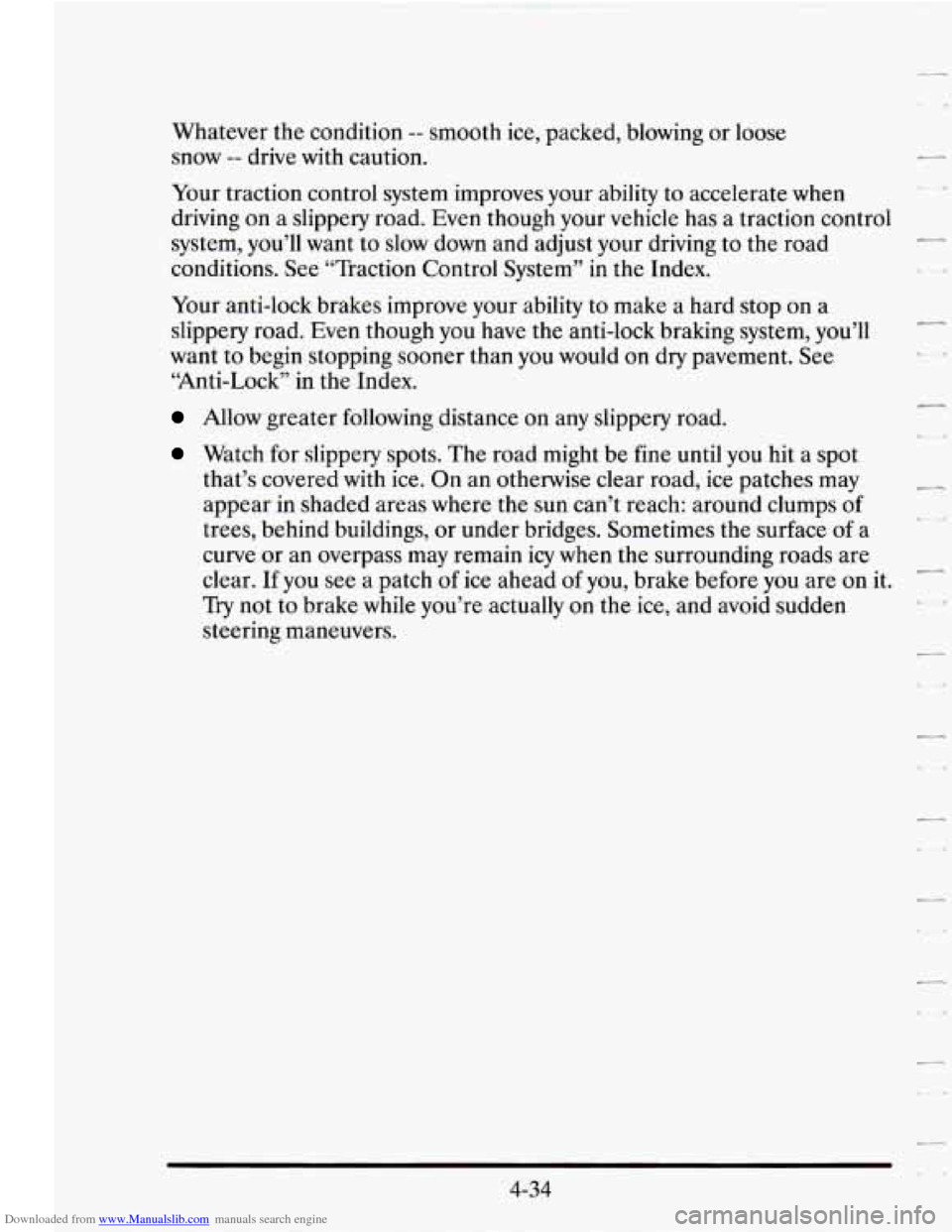
Downloaded from www.Manualslib.com manuals search engine Whatever the condition -- smooth ice, packed, blowing or loose
snow
-- drive with caution.
Your traction control system improves your ability to accelerate when
driving on a slippery road. Even though your vehicle has a traction control
system, you’ll want to slow down and adjust your driving to the road
conditions. See “Traction Control System” in the Index.
Your anti-lock brakes improve your ability to make a hard stop
on a
slippery road. Even though you have the anti-lock braking system, you’ll
want to begin stopping sooner than you would
on dry pavement. See
“Anti-Lock” in the Index.
Allow greater following distance on any slippery road.
c-
Watch for slippery spots. The road might be fine until you hit a spot
that’s covered with ice. On an otherwise clear road, ice patches may
appear in shaded areas where the sun can’t reach: around clumps
of
trees, behind buildings, or under bridges. Sometimes the surface of a
curve or an overpass may remain icy when the surrounding roads are
clear. If you see a patch
of ice ahead of you, brake before you are on it.
Try not to brake while you’re actually on the ice, and avoid sudden LJ
steering maneuvers.
c-
7
4-34
Page 319 of 410
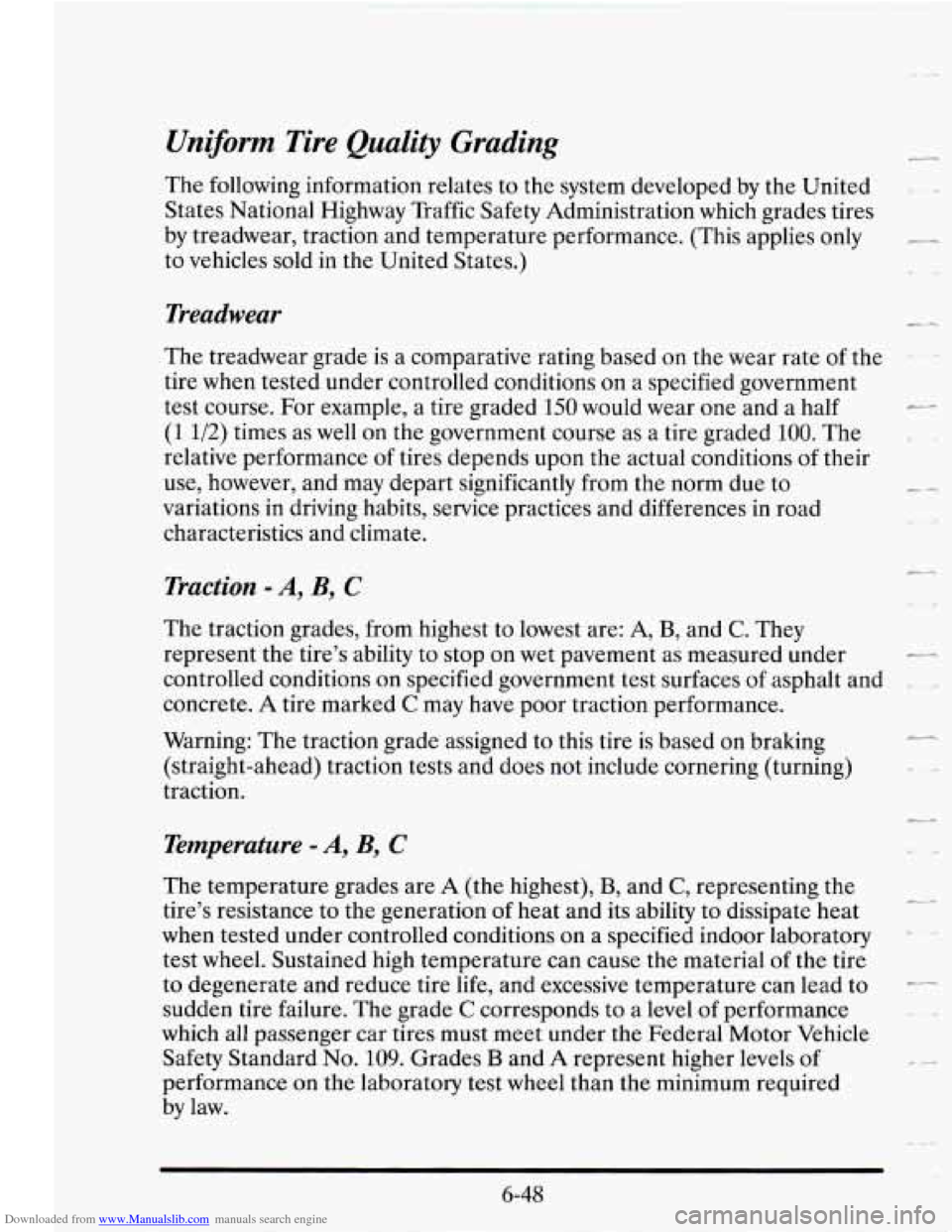
Downloaded from www.Manualslib.com manuals search engine Uniform Tire Quality Grading
The following information relates to the system developed by the United
States National Highway Traffic Safety Administration which grades tires
by treadwear, traction and temperature performance. (This applies only
to vehicles sold
in the United States.)
Treadwear
The treadwear grade is a comparative rating based on the wear rate of the
tire when tested under controlled conditions on a specified government
test course. For example,
a tire graded 150 would wear one and a half
(1 1/2) times as well on the government course as a tire graded 100. The
relative performance
of tires depends upon the actual conditions of their
use, however, and may depart significantly from the norm due to
variations in driving habits, service practices and differences in road
characteristics and climate.
Traction - A, B, C
The traction grades, from highest to lowest are: A, B, and C. They
represent the tire’s ability to stop on wet pavement as measured under
c_
controlled conditions on specified government test surfaces of asphalt and
concrete.
A tire marked C may have poor traction performance.
-
L-
Warning: The traction grade assigned to this tire is based on braking
(straight-ahead) traction tests and does not include cornering (turning)
traction.
Temperature - A, B, C
The temperature grades are A (the highest), B, and C, representing the
tire’s resistance to the generation
of heat and its ability to dissipate heat
when tested under controlled conditions
on a specified indoor laboratory .
test wheel. Sustained high temperature can cause the material of the tire
to degenerate and reduce tire life, and excessive temperature can lead
to -
sudden tire failure. The grade C corresponds to a level of performance
which all passenger car tires must meet under the Federal Motor Vehicle
Safety Standard
No. 109. Grades B and A represent higher levels of
performance on the laboratory test wheel than the minimum required
by law.
6-48
Page 338 of 410
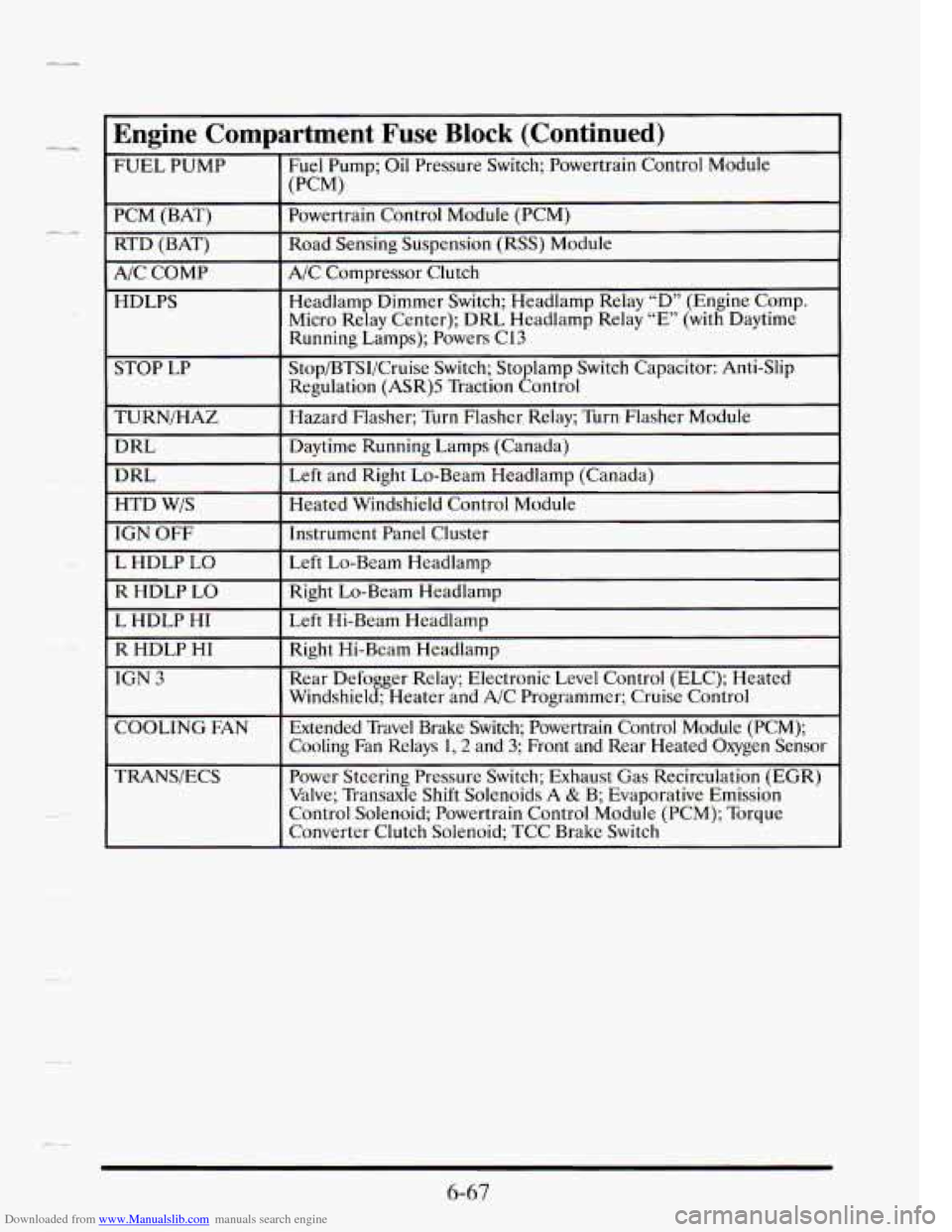
Downloaded from www.Manualslib.com manuals search engine Engine Compartment Fuse Block (Continued)
FUEL PUMP Fuel Pump; Oil
Pressure Switch; Powertrain Control Module
(PW
PCM (BAT)
Headlamp Dimmer Switch; Headlamp Relay “D” (Engine Comp.
HDLPS A/C
Compressor Clutch
A/C COMP Road Sensing
Suspension (RSS) Module
RTD (BAT) Powertrain Control
Module (PCM)
Micro Relay Center); DRL Headlamp Relay
“E” (with Daytime
Running Lamps); Powers C13
STOP LP Stop/BTSI/Cruise
Switch; Stoplamp Switch Capacitor: Anti-Slip
Regulation (ASR)S Traction Control
I
TURN/HAZ I Hazard Flasher; Turn Flasher Relay; Turn Flasher Module
DRL
Rear Defogger Relay; Electronic Level Control (ELC); Heated
IGN 3 Right Hi-Beam Headlamp
R HDLP HI Left Hi-Beam Headlamp
L HDLP
HI Right Lo-Beam Headlamp
R HDLP LO Left Lo-Beam Headlamp
L HDLP
LO
Instrument Panel Cluster IGN OFF
Heated Windshield Control Module
HTD W/S
Left and Right Lo-Beam Headlamp (Canada) DRL
Daytime
Running Lamps (Canada)
Windshield; Heater and
A/C Programmer; Cruise Control
COOLING
FAN Extended Travel Brake Switch; Powertrain Control Module (PCM); \
Cooling
Fan Relays 1,2 and 3; Front and Rear Heated Oxygen Sensor
TRANS/ECS Power
Steering Pressure Switch; Exhaust Gas Recirculation (EGR)
Valve; Transaxle Shift Solenoids
A & B; Evaporative Emission
Control Solenoid; Powertrain Control Module (PCM); Torque
Converter Clutch Solenoid; TCC Brake Switch
6-67
Page 341 of 410
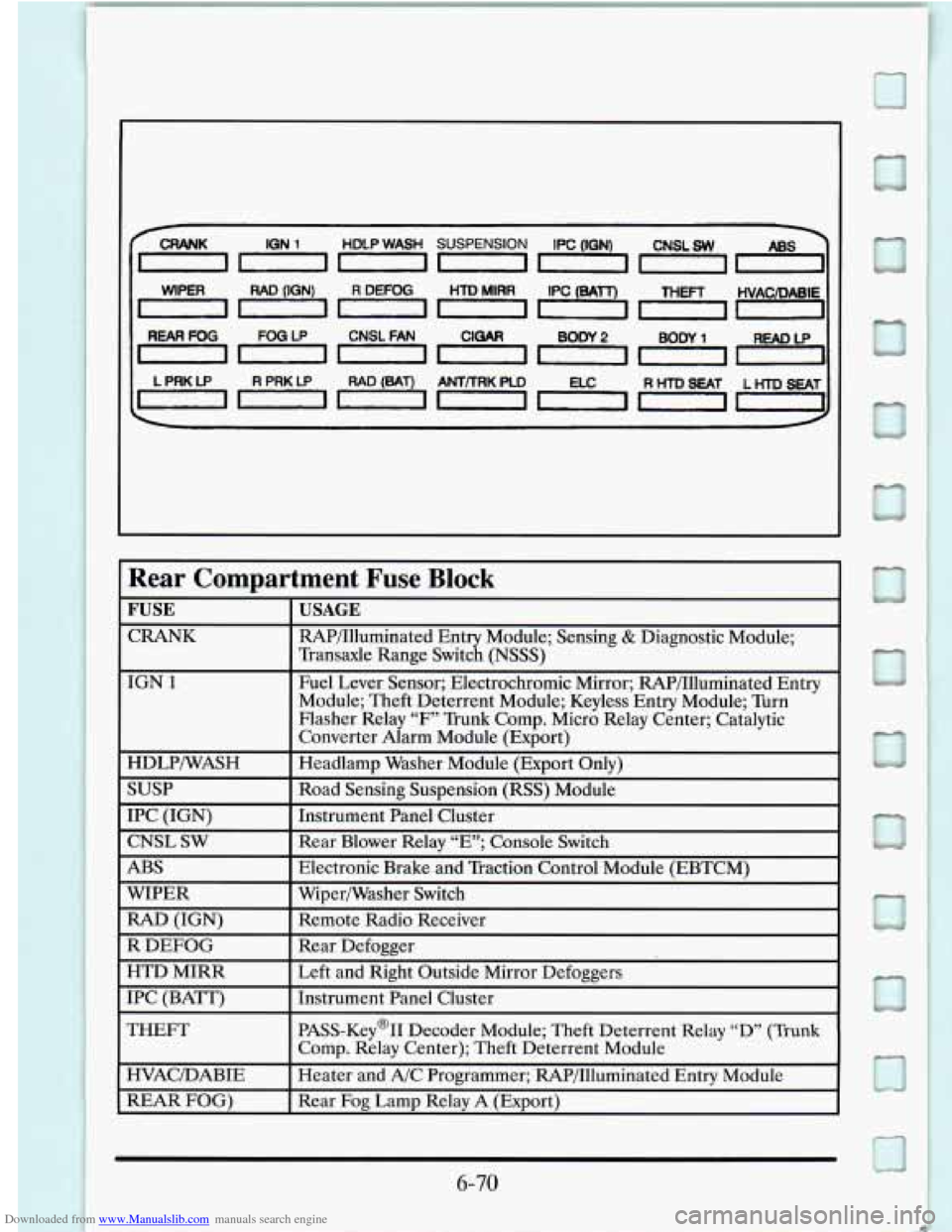
Downloaded from www.Manualslib.com manuals search engine IGN 1 HDLP WASH SUSPENSION IPC (IGN) CNSL.W
, WIPER , , RAD (1GN) I , R DEFOG I , HTDMIRR I I IPC (BA rr), , THEFT , ,H!IACDABIE,
REARFOG FOGLP CNSL FAN CIGAR Bow 2 BODY 1 READ LP
000~000
L PRK LP R PRKLP RAD (BAT) ANt/TRK PLD RHTDSEAT LHTDSEAT
Rear Compartment Fuse Block
FUSE USAGE
CRANK RAP/Illuminated Entry Module; Sensing & Diagnostic Module;
IGN
1 Fuel Lever Sensor; Electrochromic Mirror; RAP/Illuminated Entry
Transaxle
Range Switch (NSSS)
Module: Theft Deterrent Module: Kevless Entrv Module; Turn
Flasher Relay
“F” Trunk Comp. Micr6 Relay C&ter;-Catalytic
Converter
Alarm Module (Export)
HDLPWASH Headlamp Washer Module (Export Only)
SUSP Road Sensing Suspension (RSS) Module
IPC (IGN) Instrument Panel Cluster
CNSL
SW Rear Blower Relay “E; Console Switch
ABS Electronic Brake and Traction Control Module (EBTCM)
WIPER Wipermasher Switch
RAD (IGN) Remote Radio Receiver
R DEFOG Rear Defogger
HTD MIRR Left and Right Outside Mirror Defoggers
IPC (BAn) Instrument Panel Cluster
THEFT PASS-Key@II Decoder Module; Theft Deterrent Relay “D” (Trunk
Como. Relav Center); Theft Deterrent Module
HVAC/DABIE Heater and
A/C Programmer; RAP/Illuminated Entry Module
REAR FOG) Rear Fog Lamp Relay A (Export)
,I
6-70
Page 396 of 410
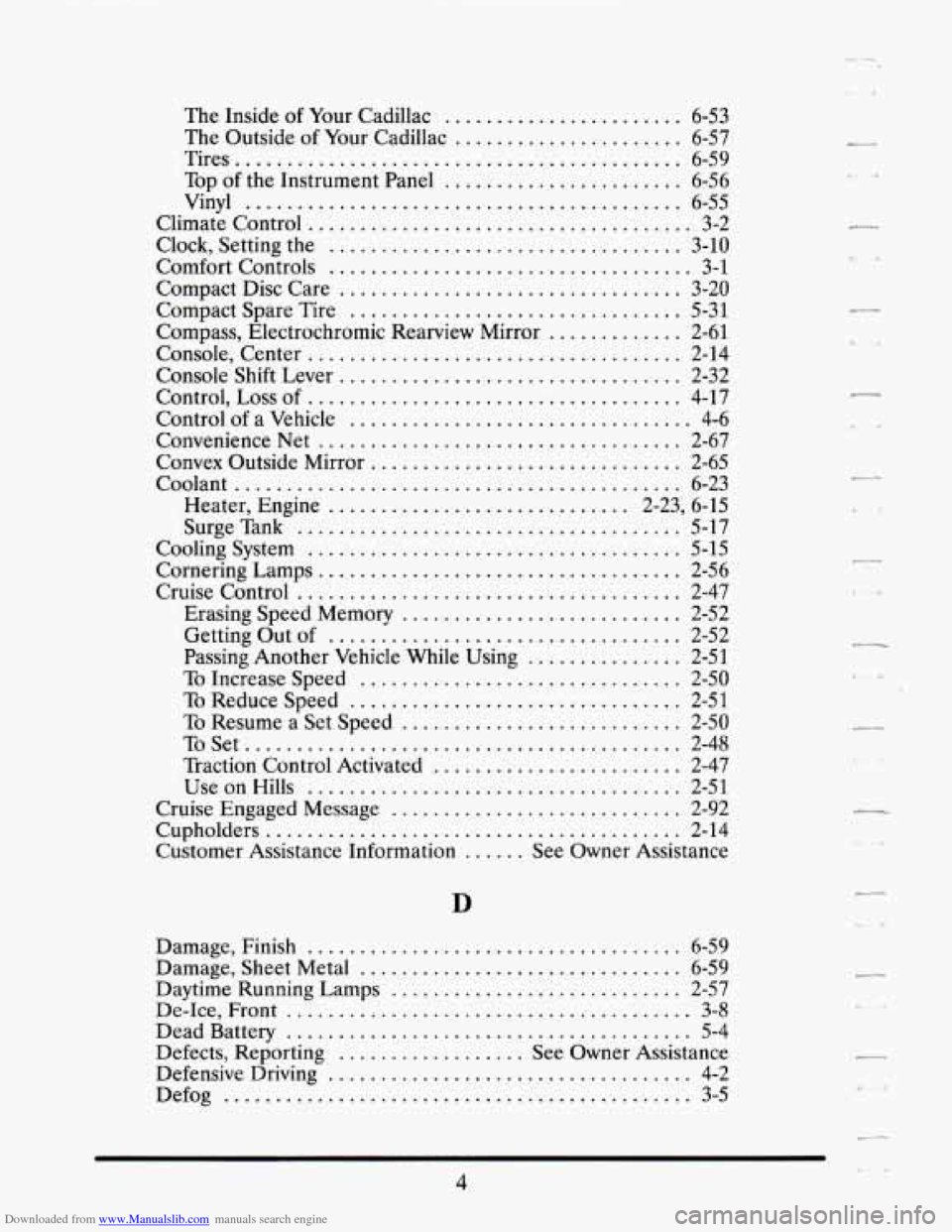
Downloaded from www.Manualslib.com manuals search engine ..
-A ..
The Inside of Your Cadillac ....................... 6-53
The Outside of Your Cadillac ...................... 6-57
Tires ........................................... 6-59
Top of the Instrument Panel ....................... 6-56
Vinyl .......................................... 6-55
Climate Control ..................................... 3-2
Clock. Setting the .................................. 3-10
Comfort Controls ................................... 3-1
Compact Disc Care .................................. 3-20
Compact Spare Tire ................................ 5-31
Compass, Electrochromic Rearview Mirror ............. 2-61
Console. Center .................................... 2-14
Console Shift Lever ................................. 2-32
Control. Loss of .................................... 4-17
Control of a Vehicle ................................. 4-6
Convenience Net ................................... 2-67
Convex Outside Mirror .............................. 2-65
Coolant ........................................... 6-23
Heater. Engine ............................. 2.23. 6.15
SurgeTank ..................................... 5-17
Cooling System .................................... 5-15
Cornering Lamps ................................... 2-56
Cruise Control ..................................... 2-47
Erasing Speed Memory ........................... 2-52
Getting Out of .................................. 2-52
Passing Another Vehicle While Using ............... 2-51
To Increase Speed ............................... 2-50
To Reduce Speed ................................ 2-51
To Resume a Set Speed ........................... 2-50
To Set .......................................... 2-48
Traction Control Activated ........................ 2-47
Use on Hills .................................... 2-51
Cruise Engaged Message ............................ 2-92
Cupholders ........................................ 2-14
Customer Assistance Information ...... See Owner Assistance
Damage. Finish
.................................... 6-59
Damage. Sheet Metal ............................... 6-59
Daytime Running Lamps ............................ 2-57
De.Ice. Front ....................................... 3-8
Dead Battery ....................................... 5-4
Defects. Reporting .................. See Owner Assistance
Defensive Driving
................................... 4-2
Defog ............................................. 3-5
.
.
.
.
.
.
.
.
.
.
4
Page 407 of 410

Downloaded from www.Manualslib.com manuals search engine .
.
r
.
.
..
.
TopStrap ......................................... 1-40
Torque Lock
....................................... 2-33
Torque. Wheel Nut
................................. 5-30
Towing a Trailer
.................................... 4-40
Towing Your Vehicle
................................ 5-10
Traction Active Message
........................ 2.94. 4.11
Traction Control System
............................. 4-11
Trailer Tongue Weight
............................... 4-42
Trailer Towing
..................................... 4-40
Brakes ......................................... 4-44
Driving on Grades
............................... 4-46
Driving with a Trailer
............................. 4-45
Engine Cooling When Towing a
.................... 4-48
Hitches
........................................ 4-44
Maintenance
.................................... 4-48
Parking on Hills
................................. 4-47
Safety Chains
................................... 4-44
Turn Signals
.................................... 4-46
Weight of a Trailer
............................... 4-42
Automatic
...................................... 6-19
Reset Message
.................................. 2-95
Transmitter, HomeLink Universal
..................... 2-69
Transmitters. Matching to Your Vehicle
................ 2-10
Trip Odometer
..................................... 2-76
Trunk Open Message
............................... 2-95
Trunk Release. Remote
............................. 2-13
Turn Signal/Multifunction Lever
...................... 2-40
Turn Signal On Message
............................. 2-95
Turn Signals When Towing a Trailer
................... 4-46
Twilight Sentinel
................................... 2-54
Total Weight
on Your Vehicle’s Tires
................ 4-43
Transaxle Fluid Change Indicator. How to Reset
................... 6-22
Trip Set Button. Driver Information Center
............. 2-89
Turn Signal and Lane Change Indicator
................ 2-41
U
Underbody Maintenance ............................ 6-60
Underhood Lamp
.................................. 2-56
15